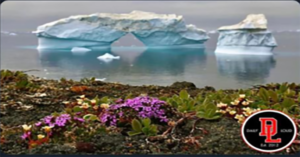Physical Address
23,24,25 & 26, 2nd Floor, Software Technology Park India, Opp: Garware Stadium,MIDC, Chikalthana, Aurangabad, Maharashtra – 431001 India
Physical Address
23,24,25 & 26, 2nd Floor, Software Technology Park India, Opp: Garware Stadium,MIDC, Chikalthana, Aurangabad, Maharashtra – 431001 India

Global climate change undoubtedly affects the entire world, and no ecosystem is immune to its effects. Polar ecosystems are particularly vulnerable, and there is a lot of misleading information being spread about the impact of climate change on these ecosystems. This investigation examines some posts about environmental changes in Antarctica.
Social media posts
Social media users shared the picture with the message, “Flowers are now starting to bloom in Antarctica, and experts say this is not good news.” Many people viewed the message and liked it.

The Climate Fact Check Team decided to fact-check this.
Fact Check
As the last untouched wilderness on Earth, Antarctica is experiencing an extraordinary metamorphosis: Flowers are blooming. This article explores the ramifications of fast plant growth and the scientific studies done on Signy Island, a subantarctic location with shifting climate conditions. Driven by human-caused temperature rise, the burgeoning greenery not only awes with its beauty but also signals the need for rapid care due to the ecological ramifications.
When considering the Antarctica Continent only contains two known species of native plants due to its challenging environment, including Antarctic pearlwort, or Colobanthus quitensis, and Antarctic hair grass, or Deschampsia antarctica, the southernmost blooming plant in the world.
1. Native flowering plants in Antarctica
Under the harsh circumstances of Antarctica, the hardy Antarctic Hair Grass, formally named Deschampsia antarctica, flourishes. Its look of tufts and grassiness belies its tolerance to cold weather, severe winds, and little sunshine.

Colobanthus quitensis, or the Antarctic Carnation, is a fragile plant that grows in the harsh Antarctic climate and produces unusual white and pink blossoms.

Additionally, the study found that a decrease in fur seal disturbance – such as “crushing/flattening, color changes due to urine deposition” – has contributed to the increased growth of both plants.
2. Indices of Change – Quick Development in Antarctica
Between 2009 and 2019, scientific surveillance on Signy Island revealed a five-fold rise in Antarctic Pearlwort growth and a ten-fold increase in Antarctic Hair Grass growth. The main cause is the increasing temperature, which is upsetting the chilly homeostasis of the continent. This study shows that temperatures in Antarctica are rising quickly due to human-caused global warming, which benefits native vegetation and promotes faster growth rates.
However, the slow-growing mosses and lichens are ecologically threatened by the thriving Antarctic Hair Grass and Antarctic Pearlwort, disturbing the delicate equilibrium that has existed for millennia.
3. Antarctica and the global Climate Change
As a sobering reminder that no area of our globe is immune to the effects of rising global temperatures, the blooming of flowers in Antarctica reflects the crisis’s deep effects. The distinct ecology of Antarctica is perfectly adapted to the harsh climate of the continent, which is marked by severe circumstances and a low level of biodiversity. Climate change’s rapid changes pose a threat of irreparable ecological harm.
4. Misleading flowering image
However, we could verify that the picture is a stock photo of flowers in Greenland, shot by Sergey Uryadnikov and sold for $19.99 on Alamy Stock Photo. “Iceberg floating in the water off the coast of Greenland,” was the caption that originally appeared on the picture. Blooms along the water. The scenery and environment of Greenland. It also seems like the Facebook users turned the original image horizontally.
Conclusion
The post is partially correct in that warming in Antarctica has increased flowering plants, however, the image is misleading and was taken in Greenland.
A remarkable and worrisome event, the blooming of flowers in Antarctica underscores the significant effects of climate change on the world’s most isolated areas. The swift expansion of Antarctic Hair Grass and Antarctic Pearlwort is a potent signal of rising temperatures and their effects on the continent’s distinct ecology. We must take immediate action to minimize the effects of the climate catastrophe, cut greenhouse gas emissions, and save the planet’s most delicate ecosystems. The flowers of Antarctica are a call to action, symbolizing that we are all responsible for protecting our planet and that the time for change is now.
-With inputs from Nuwandhara Mudalige –